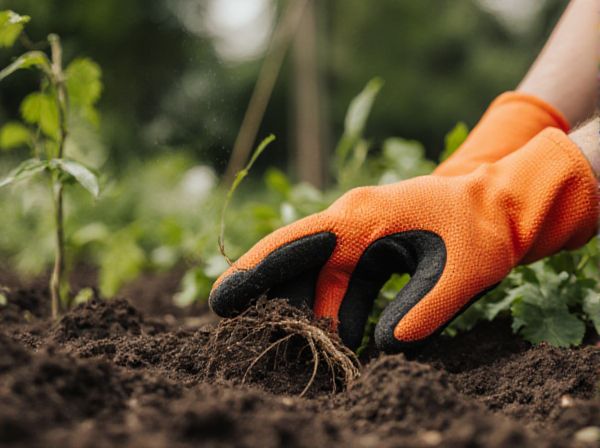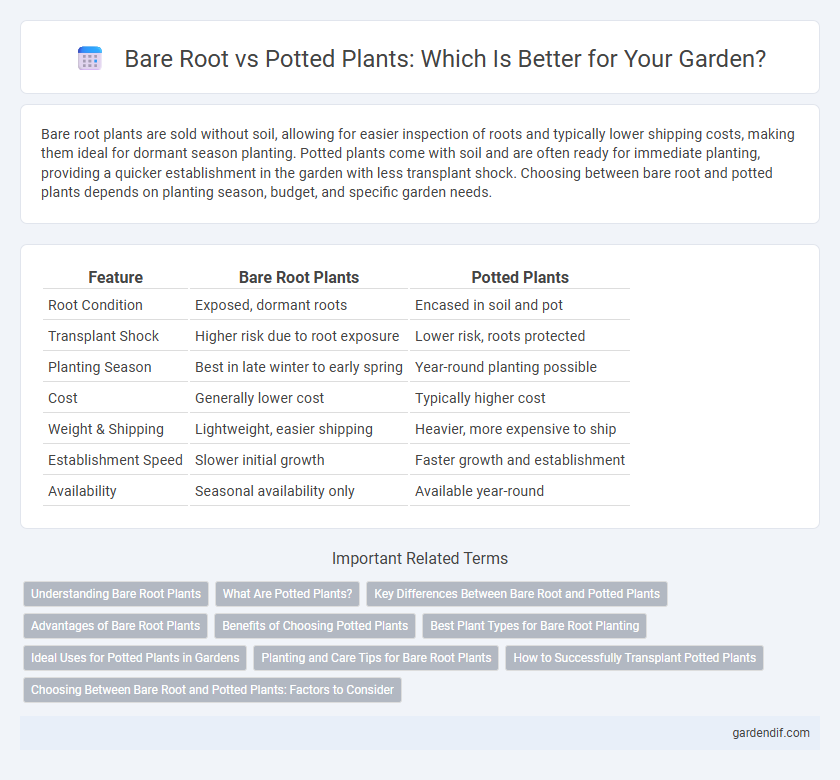
Bare root vs Potted plants Illustration
Bare root plants are sold without soil, allowing for easier inspection of roots and typically lower shipping costs, making them ideal for dormant season planting. Potted plants come with soil and are often ready for immediate planting, providing a quicker establishment in the garden with less transplant shock. Choosing between bare root and potted plants depends on planting season, budget, and specific garden needs.
Table of Comparison
| Feature | Bare Root Plants | Potted Plants |
|---|---|---|
| Root Condition | Exposed, dormant roots | Encased in soil and pot |
| Transplant Shock | Higher risk due to root exposure | Lower risk, roots protected |
| Planting Season | Best in late winter to early spring | Year-round planting possible |
| Cost | Generally lower cost | Typically higher cost |
| Weight & Shipping | Lightweight, easier shipping | Heavier, more expensive to ship |
| Establishment Speed | Slower initial growth | Faster growth and establishment |
| Availability | Seasonal availability only | Available year-round |
Understanding Bare Root Plants
Bare root plants are sold without soil, exposing their roots for easier inspection and reduced shipping weight, making them ideal for dormant season planting. These plants typically establish faster after transplanting due to minimal root disturbance and better root-soil contact. Gardeners favor bare root plants for their cost-effectiveness and the ability to select robust root systems, especially in trees, shrubs, and perennials.
What Are Potted Plants?
Potted plants are grown and sold in containers filled with soil or a growing medium, allowing for easy transport and immediate planting. These plants maintain their root systems enclosed within the pot, minimizing transplant shock and providing consistent moisture levels. Ideal for gardeners seeking convenience and rapid establishment, potted plants offer a ready-to-use solution for landscaping and indoor decoration.
Key Differences Between Bare Root and Potted Plants
Bare root plants are sold without soil, exposing their root systems and enabling easier inspection for health and diseases, while potted plants are grown and sold in containers with soil, promoting continuous root growth before transplantation. Bare root plants typically have a lower purchase price and require planting during dormancy to reduce transplant shock, whereas potted plants can be planted year-round and establish quicker due to their mature root system contained in the pot. Choosing between bare root and potted plants depends on factors like planting season, site readiness, and budget considerations in landscape or garden projects.
Advantages of Bare Root Plants
Bare root plants offer significant advantages such as easier transportation and handling due to their lightweight and compact form, reducing shipping costs and damage risk. They establish more quickly in the soil since their roots are not confined by a pot, allowing for faster growth and stronger root systems. This method also tends to be more cost-effective and environmentally friendly, minimizing plastic waste associated with potted plants.
Benefits of Choosing Potted Plants
Potted plants offer the benefit of being ready to grow immediately, as their root systems remain intact and undisturbed, reducing transplant shock compared to bare root plants. They provide consistent moisture and nutrients, promoting healthier growth and higher survival rates in gardens or landscapes. The convenience of easy handling and immediate visual appeal makes potted plants an excellent choice for both novice and experienced gardeners.
Best Plant Types for Bare Root Planting
Bare root planting is best suited for deciduous trees, shrubs, and perennials such as roses, maples, and dogwoods due to their dormant root systems, which reduce transplant shock and promote faster establishment. These plants benefit from bare root techniques because their roots are easier to inspect for health and damage before planting, ensuring vigorous growth. In contrast, evergreens and plants with sensitive roots typically perform better as potted specimens where root moisture and temperature can be controlled.
Ideal Uses for Potted Plants in Gardens
Potted plants are ideal for container gardening, patio decoration, and balcony displays, allowing flexible placement and easier control of soil conditions and watering. Their root systems remain intact and undisturbed, promoting faster growth and better establishment when transplanted. Potted plants are perfect for seasonal flower arrangements, small-space gardening, and areas with poor soil quality where direct planting is challenging.
Planting and Care Tips for Bare Root Plants
Bare root plants require immediate planting to prevent root desiccation and are best planted during dormancy for optimal establishment. Soak the roots in water for several hours before planting to rehydrate them and trim any damaged or excessively long roots to promote healthy growth. After planting, mulch around the base to retain moisture and water consistently, ensuring the soil remains evenly moist but not waterlogged.
How to Successfully Transplant Potted Plants
To successfully transplant potted plants, carefully remove the plant from its container, gently loosening the root ball without causing damage to the roots. Ensure the new planting hole is twice as wide as the root ball to allow ample space for root expansion and improve soil aeration. Water thoroughly immediately after planting and maintain consistent moisture levels to help the plant establish itself in its new environment.
Choosing Between Bare Root and Potted Plants: Factors to Consider
Choosing between bare root and potted plants depends on factors such as planting season, soil condition, and transportation logistics. Bare root plants are typically more affordable and easier to transport but require immediate planting in dormant seasons to reduce transplant shock. Potted plants offer year-round planting flexibility and established root systems, making them ideal for less experienced gardeners or unfavorable timing.
Bare root vs Potted plants Infographic

 gardendif.com
gardendif.com